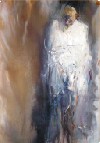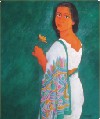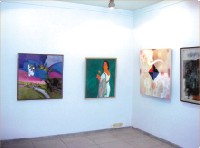living
with art
 What
is the value of an art?
What
is the value of an art?
IF you are an art lover, you may want to pay 100 million dollars to
buy 1905 masterpiece by Pablo Picasso, "Garcon a la Pipe"
(Boy with a Pipe). That's the price some art lover paid to buy this
painting at an auction earlier this month.
If you can't appreciate art, however, it's a different
ball game. The Talibans simply destroyed the ancient statue of the
Buddha in Afghanistan. Encroachers in Bangladesh's Mahastangarh collect
and sell 2000 year-old bricks and artefacts for two bucks. In addition,
Finance Minister Saifur Rahman wants to impose tax on art works, perhaps
considering them as industrial productions. If you are not an art
lover of any sort, don't bother to read beyond this part of this feature.
Like most people I have never been an art critic and
probably will not be able to afford a good painting for myself. I
don't really understand cubism or Dadaism, but I like to look at paintings,
the colour textures and structures that automatically stir my visual
sensors and leave me with a pleasant feeling. I know many people who
share this same simplistic feeling about art and painting.
You
like it? It's art for you
"There is no need to understand the hidden meaning," veteran
journalist and art critic Wahidul Haque once told me explaining how
to recognise good art, "You don't judge art by its technicalities.
You judge art by how you feel about it when you see it."
Renowned artists believe that we now have a society
with growing number of people who appreciate the aesthetic value of
art side by side with the rising number of art collectors. Nowadays
we get to see paintings in more public and private places than ever
before.
"A growing number of people are now buying art,"
says artist Quaiyum Chowdhury.
 "Even
the middle class people tend to buy small paintings. A larger number
of businessmen, corporate clients, foreigners, embassies and similar
kind of people have emerged as art buyers. In the last ten years many
art galleries have come up although a few of them have also closed
down," he adds.
"Even
the middle class people tend to buy small paintings. A larger number
of businessmen, corporate clients, foreigners, embassies and similar
kind of people have emerged as art buyers. In the last ten years many
art galleries have come up although a few of them have also closed
down," he adds.
Explaining this market growth, he says, "Peoples'
cultural exposure has increased because of the role of mass media
like the television. Art exhibitions, including international art
exhibitions also increased and contributed to this cultural orientation."
Chowdhury points out that art has also become a status
symbol in our society. "A painting of Jainul or Qamrul is a priceless
possession, one could imagine. Besides when a person hangs a painting
in his room, it symbolises his taste," he notes.
"The growth of apartments also contributed to
art sales. Amid (the claustrophobic) walls of the apartments, an art
piece can simulate the feeling of a window and give you a feeling
of openness. That is why many housing companies buy art," Chowdhury
says.
Side by side with wider art market, increasing job
prospects in government and non-government organisation, advertising
firms, etc have also helped increase the number of artists. Living
on art no longer means living in poverty and struggle.
"Our artists are of international standard. Many
of our artists are internationally recognised and many have bagged
international awards," Chowdhury points out.
What
medium of art can you get?
Artist Shishir Bhattacharya says the art market is dominated by paintings.
"From the Pakistan regime when the first gallery came up, paintings
had been the major medium that people bought," he notes.
Some watercolour works, boutique and graphic works
are also sought after. Of these three, graphic arts are cheap because
these are not unique. Graphic arts are copied and made available at
all galleries and their sales do not generate much profit for the
gallery owners or the artists.
Sculptures made of wood, clay, terracotta or casting
iron can be costly. "More importantly sculptures are not preferred
for room decoration in our society," he says.
Who
buys what
"Foreigners in the past preferred paintings that have reflection
of Bangladesh's reflection. A landscape. A rural setting. This trend
is still there but the number of art works in this line has decreased
because of overall development in the field," says Shishir.
Abstract works are now most popular. "These have
visual appeal because they serve the purpose of room decoration. Many
buyers come with the mind-set that they want a painting in a certain
shade for their drawing room," Shishir notes, "They prefer
'smart' works. If the artist is somewhat renowned, even better. People
who have become wealthy in recent times are this kind of buyer."
Educated elite buyers have their eyes for works of Jainul or Qamrul
and their likes.
People above the age of 40 like to buy art for office and home decoration.
Sometimes they assign architects or interior decorators to go get
paintings which should best match the settings of their office, seminar
rooms or homes.
Some buyers will look for paintings of females only.
Some will buy art that will represent their sense of nationalismwhether
they really believe in it or not. "They would want a picture
of a typical village as if to say this is what they believe in,"
quips Shishir.
There are some wealthy art critics who go beyond the
visual appeal and understand the intrinsic value of an artwork, and
they would pick up only the best works. Some of these critics are
well known in the society. They later sell these best works back to
galleries in appropriate times.
 Where
to get them?
Where
to get them?
It may sound unbelievable now, but even a couple of decades back renowned
artists used to persuade friends and wealthy people to buy their works.
There were a very few commercial sales outlets. The life of artists
was synonymous to struggle. The only occasion where unknown people
would buy a painting or a sculpture was through an exhibition.
The first commercial art gallery came up in the fifties.
However, it was inadequate to serve the artists as a sale point.
Over the years, though, many galleries came uptremendously
helping the artists to make a living by selling their commercial and
serious works. They pay the gallery owners a certain percent of commission
and thus they also have people who promote art works in their personal
interest.
Presently there are some galleries in the Gulshan-Banani
areas which sell both serious and commercial works. They even sell
the works of Jainul and Qamrul.
Most galleries, however, focus on selling commercial
works.
Well-known galleries include Chitrak, Shilpangan,
Shilporag, Bengal, Saju Art Gallery (one of the oldest), Tivoli etc.
The latest one that is coming up in Uttara is Gallarikaya.
Most sought-after works of Bangladeshi artists
Rare
and most expensive works of late and pioneering artists
Jainul Abedin
Qamrul Islam
SM Sultan
Contemporary senior artists
Shafiuddin Ahmed (sells rarely)
Monirul Islam
Shahbuddin
Other sought after artists
Shafiuddin Ahmed
Mohammad Kibria
By
Sharier Khan
 gallerikaya
gallerikaya
A
few artists in the past have set up art galleries. Some have succeeded
in running them but most have closed down their ventures for one reason
or another. Artist Goutam Chakrabarti has taken the latest venture
to set up an art gallery in Uttara and he believes that his one will
operate in the long run.
"I
intend to put up works of around 50 living artists in the gallery
in the beginning," says Goutam, "The gallery opens on May
28 with a three-week art exhibition that I titled as Udbhodon (inauguration)."
The
inauguration will have 50 artworks or one piece per artist. Later
on, Goutam plans to keep 60 to 70 paintings and art works at the 1700
square feet gallery.
 Terming
it as his dream project, Goutam plans to keep his gallery open for
year-round sale and display of works by major artists. "If people
want to buy the works of a specific artist, they may contact us and
we can arrange an appointment," he notes.
Terming
it as his dream project, Goutam plans to keep his gallery open for
year-round sale and display of works by major artists. "If people
want to buy the works of a specific artist, they may contact us and
we can arrange an appointment," he notes.
What
made him decide on opening a gallery at the ground floor of his two
storey residence?
"I
grew up in an artist family," Goutam points out referring to
his artist father Devdas Chakrabarti, "I am an artist and a designer
myself and this is my trade. So why not make a gallery when I have
the space for a gallery and when I know all the artists?"
Gallery
management can be a pain in the neck for an artist in the long run,
however. Goutam admits this part. "Normally an artist undergoes
a lot of hassle organising a gallery and ensuring its sales. To manage
Gallerikaya, I will use the management of Karukrit (Goutam's design
and advertising firm)."
 "There
are more than a thousand active artists across Bangladesh," says
Shishir Bhattacharya. "We get to see a good level of participation
of these artists during exhibitions."
"There
are more than a thousand active artists across Bangladesh," says
Shishir Bhattacharya. "We get to see a good level of participation
of these artists during exhibitions."
He
notes, "Most galleries tend to pay more focus on putting up commercial
arts. There are a few, though, which put up both commercial and critical
works. I believe Goutam's gallery will be a serious one."
By
Sharier Khan
 buying
a good piece of art
buying
a good piece of art
IN
Dhaka, the best place where you can get hold of an artwork by established
artists would be Bengal Shilpaloy situated at 275, Road no 27, Dhanmondi.
Gallery Chitrok is another established art gallery. Their address
is house no 21, road no 4, Dhanmondi. Then there is Shilpangon, situated
at 25/5, Dhanmondi. Shilporag is situated at house no 15, road no
16, Dhanmondi. The oldest of all the painting sellers is Shaju art
gallery. Their address is 40/42, North DCC Supermarket, Gulshan no
2. The newly opened Gallery Kaya in Uttara is also a good place to
buy paintings.
There
are other places you can also check out. Current and ex students of
Fine Arts have a wonderful arrangement for the art lovers of Dhaka.
Every Friday, at Mollar Stall opposite the institute they arrange
a Chabir Haat. It starts at around 11 in the morning and
goes on till 5 in the afternoon. This place is an open platform of
artist where literally everyone can display his or her work of art.
You will get paintings and sculptures at a very reasonable price at
the Chabir Haat. With these artworks comes a free chat with
the artist in person.
In
all these places, artists themselves fix the prices. They give their
work for display. In the galleries price depends on how established
the artist is in the arena. Senior and established artists get a special
value in the art galleries. Chabir Haat is a bit different
in appraising artists. As it is an open ground for artists and art
lovers, everyone, even the youngest of artists can present their work.
Regular
visits to art exhibitions arranged by Zainul Gallery of the Fine Arts
Institute, Shilpokala Academy, and Alliance Francaise de Dhaka can
also be a good way of checking out art pieces in focus.
By
Shahnaz Parveen

